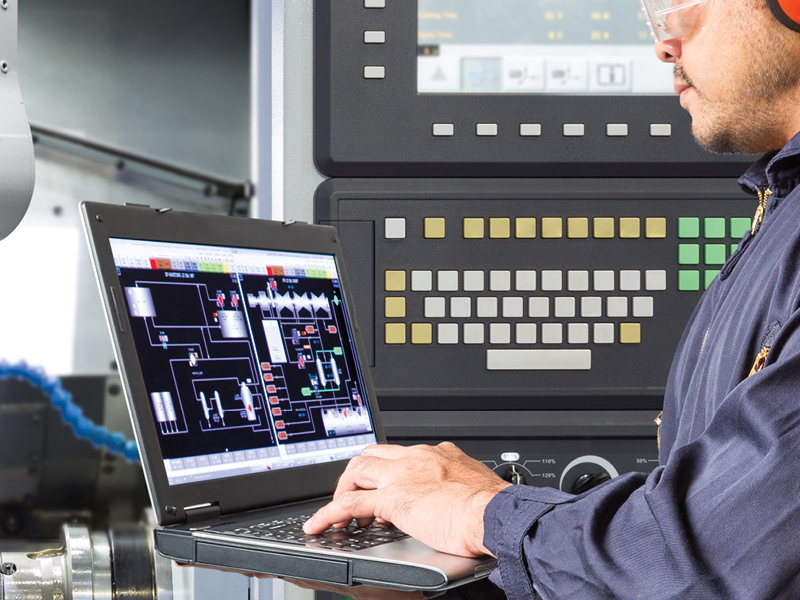MANUFACTURING EXECUTION & AUTOMATION SOFTWARE & CONTROLS

Advances in machine tool computer numerical controls (CNCs) and CAD/CAM software have made programming complex, high-production CNC equipment simpler and faster with less chance for error.
Narrow by Manufacturing Execution & Automation Software & Controls Product Category
FAQ: Manufacturing Execution & Automation Software & Controls
What is Enterprise Resource Planning (ERP)?
Enterprise Resource Planning (ERP) is the ability to deliver an integrated suite of business applications. ERP tools share a common process and data model, covering broad and deep operational end-to-end processes, such as those found in finance, HR, distribution, manufacturing, service and the supply chain. ERP applications automate and support a range of administrative and operational business processes across multiple industries, including line of business, customer-facing, administrative and the asset management aspects of an enterprise. ERP deployments are complex and expensive endeavors, and some organizations struggle to define the business benefits. (Source: Gartner.)
What does ERP stand for?
Enterprise Resource Planning.
Why is ERP software used in manufacturing?
ERP systems are a type of manufacturing management software that increases the organizational efficiency of a manufacturing enterprise by managing and improving how company resources are utilized. Improving and/or reducing the number of resources necessary without sacrificing quality and performance are keys to effectively improving manufacturing business growth and profitability. With ERP software, manufacturing companies have the ability to manage critical aspects of everything from shop floor operations to supply and inventory planning. (Source: QAD Inc.)
What is CAD?
Computer-aided design is a way to digitally create 2D drawings and 3D models of real-world products—before they’re ever manufactured. With 3D CAD, you can share, review, simulate, and modify designs easily, opening doors to innovative and differentiated products that get to market fast. (Source: PTC Inc.)
What is CAD/CAM?
CAD/CAM software controls CNC machines like mills, routers, lathes, and wire EDMs. CAD stands for computer-aided design, and CAM stands for computer-aided manufacturing. (Source: Mastercam)
What is CAM?
Computer Aided Manufacturing (CAM) is the use of software and computer-controlled machinery to automate a manufacturing process. (Source: Autodesk)
What is CNC?
CNC machining, or CNC manufacturing, is a process using computer numerical control (CNC) machines, which are tools such as mills and lathes guided by computer instructions that control the precision of the instruments. (Source: Universal Technical Institute)
What is the best ERP system for my shop?
Consider your objectives and requirements. First, consider exactly what you want from your system. What issues or staff inefficiencies must be resolved? Your answers should be specific in order to narrow requirements for your chosen ERP system. To avoid being overly influenced by marketing from various vendors, list your requirements before starting to research the options available. Discuss these requirements with different team members to ensure that specific needs are met.
Measure return on investment (ROI). Very often, businesses researching ERP systems find it difficult to measure ROI accurately. However, having clearly defined goals and objectives at the start will help considerably. It’s possible to measure ERP performance by:
- Calculating productivity before and after implementation.
- Documenting inventory improvements.
- Counting up savings to customers and whether lifetime value has increased.
Also consider the advantages between in-house and cloud-based ERP. The latter is often the most user-friendly option. It will probably require fewer members of the in-house team to maintain it.
Speak to fellow ERP users. You may find it difficult to speak to direct competitors about their experiences with ERP, but you could communicate with a shop reference who has goals similar to yours and can answer questions from experience. Likewise, you could post questions to online manufacturing groups to gage their opinions.
These are good questions to ask:
- Were any promises not kept by your vendor?
- Does the product do what you expected?
- Were any deadlines missed?
- Are you paying for product extensions that you do not need?
- Were hidden costs discovered after installation?
Scrutinize the demo. We recommend providing the vendor with a demo script that outlines specific functions and features that you will expect to see. Approaching the demo with an open but critical mind will save valuable time and help determine whether the software meets your goals.
Calculate the real cost. It is essential to know the true cost of ERP by calculating expenses at each stage. These include:
- Upfront cost
- Maintenance
- User adoption and training
- Support
- Recurring costs.
(Source: How to Choose an ERP System for Your Data-Driven Machine Shop)
What CAM software is best for five-axis?
Wide variation in five-axis machines and processes makes choosing the right software critical. For example, does the software only offer static tool orientation control, or more flexible contouring? Does it offer collision detection and control? Has the provider tested the CAM software on in-house five-axis machines? A simpler piece of software may be cheaper, but additional functionality and flexibility will prove more productive in the long run.
Should I program at the control or offline?
New software can improve programming accuracy compared to manually entering lines of G code at the CNC machine. Part of the embrace of CAM is to persuade the machinists to not “fiddle” with the program at the machine. This can be a hard ask for someone who has been hand programming for more than 20 years and who takes pride in the clean code they create. However, in order to reap the full benefits of CAD/CAM programming, the machinists must trust the program and stop comparing it to the blueprint. For instance, instead of producing a part by taking boxy cuts with big stepovers, the CAM software’s extra lines might produce a finer stepover at a faster feed rate, which helps the cutting tools last longer. Offline programming can also lead to more accurately quoted jobs, as well as the ability to run more complex parts.
Get Listed!
Thousands of people visit this Supplier Guide every day to source equipment and materials. Get in front of them with a free company profile.










